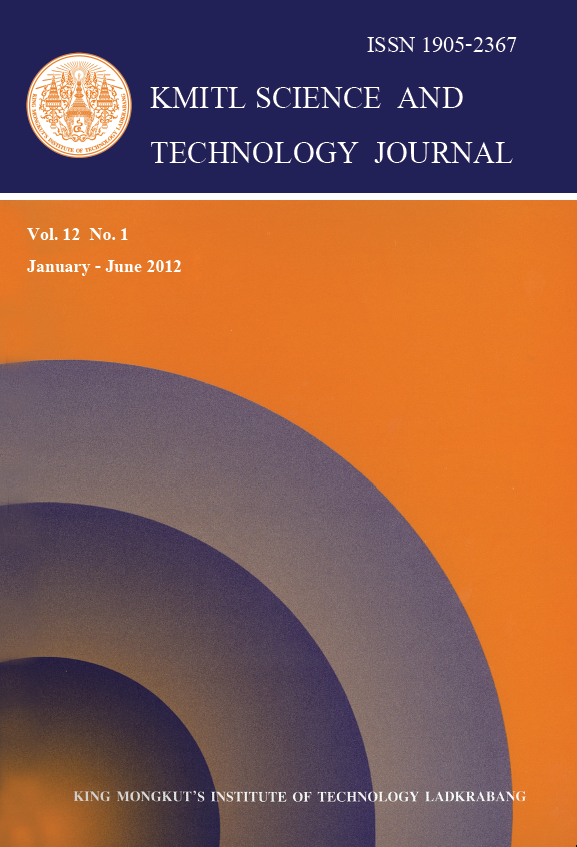The Production of 5´-nucleotides by Commercial Mushrooms Cultivated in Liquid Extracts of Water Hyacinth
Main Article Content
Abstract
Three specialty mushrooms produced commercially in Thailand, including Abalone mushroom No. 03 (Pleurotus cystidiosus O. K Miller), Hed Kon mushroom No. 02 (Lentinus squarrosulus Mont.) and Teenpok mushroom (Lentinus sajor-caju) were cultivated in four liquid media, i.e.PDB, media contained liquid extracts of water hyacinth leaves at 20, 30 and 40 g l-1 in order to select the most suitable medium for the production of flavor enhancing 5´-nucleotides. The results showed that the maximum 5´-nucleotides of 15.09 and 14.97 mg g-1 dry weight were produced from Teenpok mushroom cultivated in media containing liquid extracts of water hyacinth leaves at 30 and 40 g l-1, respectively. The maximum 5´-nucleotides of 12.75 mg g-1 was produced from Hed Kon mycelia cultivated in PDB.
Keywords: Lentinus sajor-caju, Lentinus squarrosulus, Pleurotus cystidiosus, water hyacinth, 5´ nucleotide
E-mail: kbsakrin@kmitl.ac.th
Article Details
Copyright Transfer Statement
The copyright of this article is transferred to Current Applied Science and Technology journal with effect if and when the article is accepted for publication. The copyright transfer covers the exclusive right to reproduce and distribute the article, including reprints, translations, photographic reproductions, electronic form (offline, online) or any other reproductions of similar nature.
The author warrants that this contribution is original and that he/she has full power to make this grant. The author signs for and accepts responsibility for releasing this material on behalf of any and all co-authors.
Here is the link for download: Copyright transfer form.pdf
References
[2] Erilsen, S. and Fagerson, I. S. 1976. Flavours of amino acid and peptides. International Flavors and Food Additives, 7(1), 13-16.
[3] Ninomiya, K. 1998. Natural occurrence. Food Reviews International. 14, 177-212.
[4] Solms, J. 1971. Nonvolatile compounds and flavor. In: Gustation and Olfaction (Olhloff, G.& Thomas, A. F., eds.), pp 92-110. Academic Press, London, England.
[5] Gajalakshmi, S. and Abbasi, S. A. 2002. Effect of the application of water hyacinth compost vermicompost on the growth and flowering of Crossandra undulaefolia, and on several vegetables. Bioresource Technology. 85, 197-199.
[6] Gunnarsson, C. C. and Petersen, C. M. 2007. Water hyacinths as a resource in agriculture and energy production: a literature review. Waste Management, 27, 117-129.
[7] Osemwegie, O. O., Akpaja, E., Okhuoya, J. A. and Anedu, C. 2003. Waterhyacinth, an aquatic weed as a growth substrate for Pleurotus pulmonarius and Pleurotus tuberregium (Pt-Omon 13). Nigerian Journal of Applied Science, 21, 9-14.
[8] Murugesan, A. G., Vijayalakshmi, G. S.,Sukumaran, N. and Mariappan, C. 1995. Utilization of water hyacinth for oyster mushroom cultivation. Bioresource Technology 51, 97-98.
[9] Limsoonton, T. 2000. Water hyacinth utilization in oyster mushroom cultivation. Master’s Thesis, Gradute School, Mahidol University, Bangkok, Thailand.
[10] Nageswaran, M., Gopalakrishnan, A., Ganesan, M., Vedhamurthy, A. and Selvaganapathy, E. 2003. Evaluation of waterhyacinth and paddy straw waste for culture of oyster mushrooms. Journal of Aquatic Plant Management, 41, 122-123.
[11] Wasser, S. P., and Weis, A. L. 1999. Medicinal properties of substances occurring in higher Basidiomycetes mushrooms: current perspective (review). International Journal of Medicinal Mushroom. 1, 31-62.
[12] Litchfield, J. H. 1967. Morel mushroom mycelium as a food flavoring material. Biotechnology and Bioengineering, 9, 289-304.
[13] Mau, J.-L., 2005.The umami taste of edible and medicinal mushrooms. International Journal of Medicinal Mushrooms, 7, 113-119.
[14] Mau, J.-L., Lin, H.-C., Ma, J.-T. and Song, S.-F. 2001. Non-volatile taste components of several specialty mushrooms. Food Chemistry, 73, 461-466.
[15] Yang, J.-H., Lin, H.-C. and Mau, J.-L. 2001. Non-volatile taste components of several commercial mushrooms. Food Chemistry, 72, 465-471.
[16] Mau, J.-L., Lin, H.-C. and Chen, C.-C. 2001. Non-volatile components of several medicinal mushrooms. Food Research International, 34, 521-526.
[17] Chiang, P.-D., Yen, C.-T. and Mau, J.-L. 2006. Non-volatile components of canned mushrooms. Food Chemistry, 97, 431-437.
[18] Huang, S.-J., Tsai, S.-Y., Lee, Y.-L. and Mau, J.-L. 2006. Nonvolatile taste components of fruit bodies and mycelia of Cordyceps militaris. LWT-Food Science and Technology, 39,577-583.
[19] Taylor, M. W., Hershey, R.A., Coy, K. and Olivelle, S. 1981. Improved method of resolving nucleotides by reverse-phase high performance liquid chromatography. Journal of Chromatography, 219, 133-139.
[20] Chen, H.-K. 1986. Studies on the characteristics of taste-active components in mushroom concentrate and its powderization. Master’s Thesis, National Chung-Hsing University,Taichung, Taiwan.
[21] Smith, J., Rowan, N. and Sullivan, R. 2002. Medicinal Mushrooms. Their Therapeutic Properties and Current Medical Usage with Special Emphasis on Cancer Treatments. Cancer Research, U.K.
[22] Yang, J.-H., Lin, H.-C. and Mau, J.-L. 2001. Non-volatile taste components of several commercial mushrooms. Food Chemistry 72, 465-471.
[23] Huang, S.-J., Tsai, S.-Y., Lee, Y.-L. and Mau, J.-L. 2006. Nonvolatile taste components of fruit bodies and mycelia of Cordyceps militaris. LWT-Food Science and Technology 39, 577-583.
[24] Nageswaran, M., Gopalakrishnan, A., Ganesan, M., Vedhamurthy, A. and Selvaganapathy, E. 2003. Evaluation of waterhyacinth and paddy straw waste for culture of oyster mushrooms. Journal of Aquatic Plant Management 41, 122-123.
[25] Marcelo, J. S. R., Samia, M. T. T., Vera, L. R. B. and Marina, C. 2001. Cultivation of the edible mushroom Oudemansiella canarii (Jungh.) Hohn. in lignocellulosic substrates. Brazilian Journal of Microbiology, 32, 211-214.


